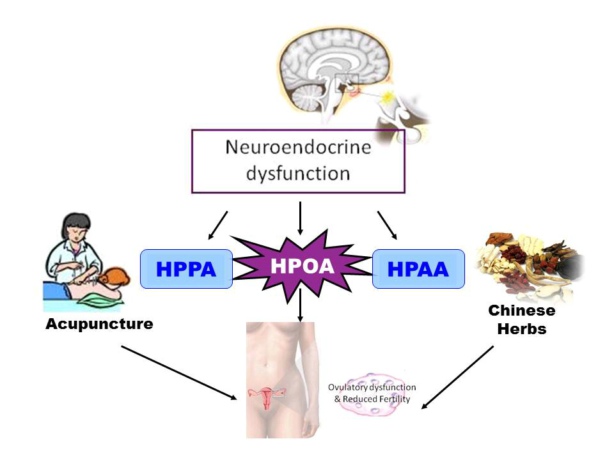Endocrinology Workgroup
Projects:
1.The neurobiologic mechanisms of perimenopausal syndrome: effect of acupuncture
2.Neurobiological mechanism of precocious puberty and Chinese herbal medicine on the regulating the abnormal function of hypothalamus-pituitary-ovary axis in rats
3.The neurobiological mechanisms of polycystic ovarian syndroem (PCOS): effect of acupuncture
The Integrative Medicine and Neurobiology Department /Endocrinology workgroup was founded in 1980s, concentrating on neuroendocrinology research of female diseases: perimenopausal syndrome, precocious puberty and polycystic ovarian syndrome. We designed these researches from clinical cases to animal models to detect the effects and mechanisms of acupuncture/ Chinese herbs. For different female diseases, the hypothalamus plays a pivotal role in pathological changes. Both acupuncture and Chinese herbs are involved in the regulation of hypothalamus-pituitary-ovary axis, hypothalamus-pituitary-adrenal axis, hypothalamus-pituitary-prolactin axis, and so on. Some important factors also take part in this kind of modulation, such as gonadotrophin hormone-releasing hormone (GnRH), corticotropin releasing hormone (CRH), Kisspeptin, estrogen receptors (ERs), Glutamate, etc. Understanding the mechanisms of acupuncture and Chinese herbs may lead to new approaches to prevent and/or treat these disorders.

Publications:
1. Yi Feng, Birgitta Weijdegård, Tienpei Wang, Emil Egecioglu, Håkan Billig, Elisabet Stener-Victorin, Ruijin Shao. Spatiotemporal expression of androgen receptors in the female rat brain during the oestrous cycle and the impact of exogenous androgen administration: a comparison with gonadally intact males. Molecular and Cellular Endocrinology. 2010 Jun 10; 321(2):161-74. ( IF 3.611)
2. Yan Sun, Jian Yu, Boying Chen , Zhanzhuang Tian. Effect of Nourishing ″Yin″- Removing ″Fire″ Chinese herb mixture on the hypothalamic kisspeptin expression in precocious rats. Journal of Ethnopharmacology, 2010,127(2):274–279. (IF 2.26)
3. Yi Feng, Julia Johansson , Ruijin Shao, Louise Mannerås, Julia Fernandez-Rodriguez , Håkan Billig and Elisabet Stener-Victorin. Hypothalamic Neuroendocrine Function in Rats with Dihydrotestosterone induced Polycystic Ovary Syndrome – Effects of Acupuncture. PLoS ONE. 2009 August, volume 4, issue 8, e6638 (IF 4.5)
4. Yi Feng, Shan Sun, Feng Zhang, Feng Guan, Tienpei Wang, Boying Chen, Yuqiu Zhang. Role of Electroacupuncture on Activation of Spinal Glia. Glia. 2009;7:S26–S171. (IF 5.9,Meeting abstract)
5. Xiaofei An, Ming He, Yi Feng, Jiangyi Yu. Central administration of Orphanin FQ inhibits GnRH secretion by ORL1 receptor in the median eminence of freely moving ovariectomized rats. Neuroscience Bulletin. 2009; 25(1):1-6. (IF 0.455)
6. Yi Feng, Huagang Lin, Ying Zhang, Lierong Li, Xuping Wu, Tienpei Wang, Youxiang Liu and Yilun Tan. Electroacupuncture Promotes Insulin-like Growth Factors System in Ovariectomized Osteoporosis Rats. The American Journal of Chinese Medicine.2008; 36(5): 889-897.(IF 1.058)
7. Yi Feng, Hong Zhao, Sulan Ma, Xiaofei An, Boying Chen. The expression of Prolactin Releasing Peptide (PrRP) changes in the Estrous Cycle of Female Rats. Neuroscience letters.2007; 419:38-42.(IF 2.085)
8. Yan Sun, Zhan-Zhuang Tian, Hong Zhao, Stephen TC Wong, Bo-Ying Chen. Characteristic of hypothalamic kisspeptin expression in the pubertal development of precocious female rats. Neurosci Lett. 2007,420:12-17. (IF 2.085)
9. Xiaofei An, Jiangyi Yu, Yi Feng, Boying Chen, Sulin Zhang. Role of hypothalamus nociceptin/orphanin FQ in pre-ovulatory luteinizing hormone surge of estrogen and progesterone-primed, ovariectomized rats. Acta Pharmacol Sin. 2007; 28 (8): 1189–1197. (IF 1.731)
10. Shubo Zhong, Zhongren Li, Lianjin Huan and Bo-Ying Chen. Neurochemical mechanism of electroacupuncture: anti-injury effect on cerebral function after focal cerebral ischemia in rats. eCAM 2007;Page 1 of 6doi:10.1093/ecam/nem062
11. Xiao Yao, Xiao-Qing Wang, Shu-Lan Ma, Bo-Ying Chen.Electroacupuncture stimulates the expression of prolactin-releasing peptide (PrRP) in the medulla oblongata of ovariectomized rats. Neuroscience Letters 2007;411: 243–248(IF 2.085)
12. Xiao Yao, Xiao Qing Wang, Shu Lan Ma, Bo Ying Chen.Sodium tanshinone IIA sulfonate derived from Slavia miltiorrhiza Bunge up-regulate the expression of prolactin releasing peptide (PrRP) in the medulla oblongata in ovariectomized rats. Biochemical Pharmacology 2006;72:582 – 587 (IF 3.617)
13. Zhan-Zhuang Tian, Hong Zhao, Bo-Ying Chen. Evaluation of the true precocious puberty rats induced by neonatal administration of Danazol: Therapeutic effects of nourishing “Yin”- removing “Fire” Chinese herb mixture. Reprod Biol & Endocrin 2005,3:38. (IF 2.634)
14. Xiaofei An, Sulan Ma, Yi Feng, Boying Chen .Nociceptin/orphanin FQ inhibits release of hypothalamic GnRH mediated by ORL1 receptor in ovariectomized rats. Acta Pharmacologica Sinica. 2005; 26: 1039-1044. (IF 1.731)
15. Hong Zhao,Zhanzhuang Tian,Yi Feng,Boying Chen. Circulating estradiol and hypothalamic corticotrophin releasing hormone enhances along with time after ovariectomy in rats: Effects of electroacupuncture. Neuropeptides. 2005; 39:433-438. (IF 2.632)
16. Hong Zhao,Zhanzhuang Tian,Yi Feng,Boying Chen. Circulating estradiol and hypothalamic corticotrophin releasing hormone enhances along with time after ovariectomy in rats: Effects of electroacupuncture.Neuropeptides. 2005; 39:433-438. (IF 2.438)
17. Hong Zhao, Zhanzhuang Tian, Junwei Hao and Boying Chen. Extragonadal aromatization increases with time after ovariectomy in rats.Reproductive Biology and Endocrinology.2005, 3:6-14. (IF 2.634)
Figure. Co-localization of AR, GnRH, and CRH in MPO neurons, determined by dual-fluorescence immunohistochemistry and confocal laser-scanning microscopy. A) Main distribution of AR, GnRH, and CRH in control female rat brain (3v = third ventricle). B–D) Co-localization of AR, GnRH, CRH, and NeuN immunoreactivity in MPO neurons. E) Co-localization of rabbit polyclonal AR antibody and mouse monoclonal AR antibody in hypothalamic MPO. F and G) Co-localization of mouse monoclonal AR antibody with GnRH or CRH
immunoreactivity in hypothalamic MPO neurons. In panels B–G, arrows indicate co-localization. Scale bars, 100 mm.
